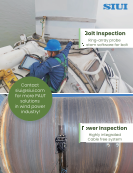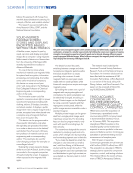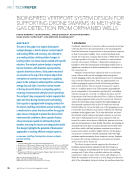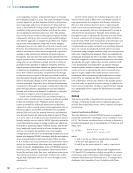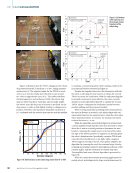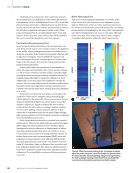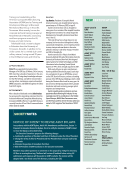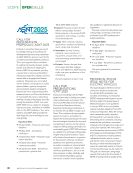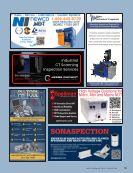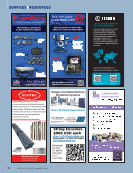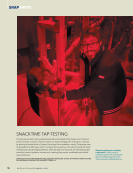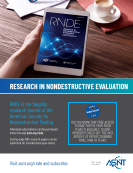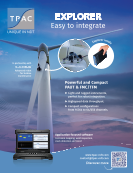over 20 years and thousands of miles of
sewer inspection video data, PipeAId has
built and trained advanced computer
vision algorithms to identify and code
sewer defects and features according
to NASSCO standards. Every defect is
geospatially mapped through a digital
twin of the collection system, providing a
highly accurate, consistent, and detailed
representation of system conditions. This
empowers utilities to make data-driven
decisions, effectively manage assets, and
optimize maintenance and repair budgets.
“This partnership is a testament to our
focus on data quality and commitment to
unlocking the power of data through an
integration-first approach,” said Andrew
Stauffer, CEO at PipeAId.
PipeAId’s AI-powered capabilities are
now available to over 500 municipalities,
utilities, and inspection contractors using
PipeLogix. Once customers purchase the
PipeAId integration, it is activated without
the need for new software training.
PipeAId pricing follows a pay-as-you-go
model based on linear feet and includes
comprehensive quality assurance.
EXTENDE RENEWS
QUALIOPI
CERTIFICATION
EXTENDE has successfully renewed its
Qualiopi certification, which is now valid
until November 2027.
Qualiopi is a French quality standard
for training centers. In addition to the
company’s ISO 9001 certification, the
Qualiopi certification underscores the
high level of EXTENDE’s “CIVA” and
“Reliability in NDE” training programs.
For EXTENDE’s French customers, this
certification means that the company’s
training programs can now be included
in any OPCO’s reference catalog, poten-
tially enabling funding support for course
registration.
ADVANCED LEGGED
ROBOT CREATED FOR
SAFER, FASTER PIPELINE
INSPECTION AND REPAIR
Tmsuk Corporation (Kyoto, Japan)
unveiled the SPD-X, a legged robot
designed for pipeline inspection, in
January. Capable of fitting through
pipes with diameters larger than 7.87 in.
(20 cm), the SPD-X can travel at speeds
of up to 0.19 mph (0.3 kph) using its
16 legs.
Developed specifically for pipeline
inspection and repair, the SPD-X is a
significant upgrade from Tmsuk’s earlier
SPD1 model, offering improved stability
and functionality. Compared to the SPD1,
the SPD-X is smaller, longer, and roughly
3× heavier. Despite its increased weight,
it maintains the same top speed and is
now fully waterproof. The SPD-X also
features an enhanced camera, offering
360° vision at 12.3 degrees, a signifi-
cant improvement over the SPD1’s 62.2
degrees. This advanced camera allows
the robot to navigate more challenging
conditions, such as pipe joint misalign-
ment or sediment buildup.
Like its predecessor, the SPD-X is
controlled remotely via a gaming pad–
inspired controller. However, its additional
advanced legs allow it to tackle obsta-
cles more efficiently. The robot is also
designed to access narrow spaces that
are otherwise hazardous or impossible
for humans to enter.
The SPD-X is part of a growing global
network of “pipebots”—robots designed
to maintain pipeline integrity. In the US
alone, a water main ruptures approxi-
mately every two minutes, resulting in a
daily loss of six billion gallons of treated
water. Traditional inspection and repair
methods are time-consuming and
labor-intensive, but robots like the SPD-X
could significantly reduce both the time
and cost of such operations.
Tmsuk’s development of the SPD-X
included extensive 3D simulations to
predict its performance in various environ-
ments, including its ability to handle sedi-
ment buildup in pipes. Real-world testing
followed, with improvements based on
feedback from SPD1 users in 2022. These
updates addressed challenges like accom-
modating both larger and smaller pipe
diameters, handling pipe blockages, and
improving water flow.
Tmsuk plans to continue developing
robots that can operate in areas humans
cannot reach, perform dangerous tasks,
and function in environments where
traditional machinery would struggle.
The company is also focused on refining
the SPD-X to perform more advanced
tasks, helping to address labor shortages
and improve safety in hazardous work
conditions.
NEW BIOMIMETIC
PANORAMIC CAMERA
MIMICS INSECT
EYES FOR REAL-
TIME IMAGING AND
MOTION DETECTION
Natural compound eyes (NCEs) were first
studied by Robert Hooke in 1664 after
SCANNER
|
INDUSTRYNEWS
Tmsuk’s SPD-X pipebot, an upgrade from its predecessor SPD1 model, has an enhanced camera
and additional legs that allow it to maneuver better through challenging areas.
12
M AT E R I A L S E V A L U AT I O N • A P R I L 2 0 2 5
CREDIT:
TMSUK
CORPORATION
sewer inspection video data, PipeAId has
built and trained advanced computer
vision algorithms to identify and code
sewer defects and features according
to NASSCO standards. Every defect is
geospatially mapped through a digital
twin of the collection system, providing a
highly accurate, consistent, and detailed
representation of system conditions. This
empowers utilities to make data-driven
decisions, effectively manage assets, and
optimize maintenance and repair budgets.
“This partnership is a testament to our
focus on data quality and commitment to
unlocking the power of data through an
integration-first approach,” said Andrew
Stauffer, CEO at PipeAId.
PipeAId’s AI-powered capabilities are
now available to over 500 municipalities,
utilities, and inspection contractors using
PipeLogix. Once customers purchase the
PipeAId integration, it is activated without
the need for new software training.
PipeAId pricing follows a pay-as-you-go
model based on linear feet and includes
comprehensive quality assurance.
EXTENDE RENEWS
QUALIOPI
CERTIFICATION
EXTENDE has successfully renewed its
Qualiopi certification, which is now valid
until November 2027.
Qualiopi is a French quality standard
for training centers. In addition to the
company’s ISO 9001 certification, the
Qualiopi certification underscores the
high level of EXTENDE’s “CIVA” and
“Reliability in NDE” training programs.
For EXTENDE’s French customers, this
certification means that the company’s
training programs can now be included
in any OPCO’s reference catalog, poten-
tially enabling funding support for course
registration.
ADVANCED LEGGED
ROBOT CREATED FOR
SAFER, FASTER PIPELINE
INSPECTION AND REPAIR
Tmsuk Corporation (Kyoto, Japan)
unveiled the SPD-X, a legged robot
designed for pipeline inspection, in
January. Capable of fitting through
pipes with diameters larger than 7.87 in.
(20 cm), the SPD-X can travel at speeds
of up to 0.19 mph (0.3 kph) using its
16 legs.
Developed specifically for pipeline
inspection and repair, the SPD-X is a
significant upgrade from Tmsuk’s earlier
SPD1 model, offering improved stability
and functionality. Compared to the SPD1,
the SPD-X is smaller, longer, and roughly
3× heavier. Despite its increased weight,
it maintains the same top speed and is
now fully waterproof. The SPD-X also
features an enhanced camera, offering
360° vision at 12.3 degrees, a signifi-
cant improvement over the SPD1’s 62.2
degrees. This advanced camera allows
the robot to navigate more challenging
conditions, such as pipe joint misalign-
ment or sediment buildup.
Like its predecessor, the SPD-X is
controlled remotely via a gaming pad–
inspired controller. However, its additional
advanced legs allow it to tackle obsta-
cles more efficiently. The robot is also
designed to access narrow spaces that
are otherwise hazardous or impossible
for humans to enter.
The SPD-X is part of a growing global
network of “pipebots”—robots designed
to maintain pipeline integrity. In the US
alone, a water main ruptures approxi-
mately every two minutes, resulting in a
daily loss of six billion gallons of treated
water. Traditional inspection and repair
methods are time-consuming and
labor-intensive, but robots like the SPD-X
could significantly reduce both the time
and cost of such operations.
Tmsuk’s development of the SPD-X
included extensive 3D simulations to
predict its performance in various environ-
ments, including its ability to handle sedi-
ment buildup in pipes. Real-world testing
followed, with improvements based on
feedback from SPD1 users in 2022. These
updates addressed challenges like accom-
modating both larger and smaller pipe
diameters, handling pipe blockages, and
improving water flow.
Tmsuk plans to continue developing
robots that can operate in areas humans
cannot reach, perform dangerous tasks,
and function in environments where
traditional machinery would struggle.
The company is also focused on refining
the SPD-X to perform more advanced
tasks, helping to address labor shortages
and improve safety in hazardous work
conditions.
NEW BIOMIMETIC
PANORAMIC CAMERA
MIMICS INSECT
EYES FOR REAL-
TIME IMAGING AND
MOTION DETECTION
Natural compound eyes (NCEs) were first
studied by Robert Hooke in 1664 after
SCANNER
|
INDUSTRYNEWS
Tmsuk’s SPD-X pipebot, an upgrade from its predecessor SPD1 model, has an enhanced camera
and additional legs that allow it to maneuver better through challenging areas.
12
M AT E R I A L S E V A L U AT I O N • A P R I L 2 0 2 5
CREDIT:
TMSUK
CORPORATION





